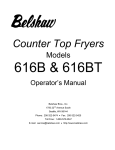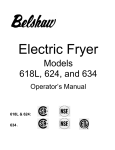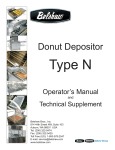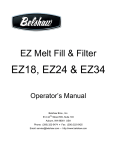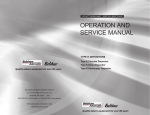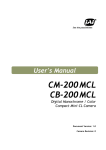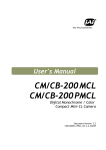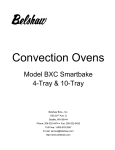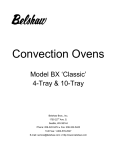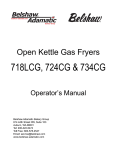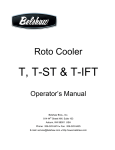Download Belshaw Brothers 616BT Operator`s manual
Transcript
Counter Top Fryers 616B & 616BT Operator’s Manual Belshaw Bros., Inc. 814 44th Street NW, Suite 103 Auburn, WA 98001 USA Phone: 206-322-5474 • Fax: 206-322-5425 E-mail: [email protected] • http://www.belshaw.com If you accept the machine from the shipping company, you are, in effect, saying that the machine is in good condition, and you must pay for the machine. Belshaw cannot pay for shipping damage, because the freight company has accepted the machine from Belshaw in good condition, and is responsible for its safe delivery. For your protection, inspect the machine to see that no parts are bent, scratched, or otherwise damaged. If any damage has occurred in shipping, file a freight claim with the shipping company immediately. IMPORTANT Keep this manual for future reference. EQUIPMENT RECORD Please provide the information below when you correspond with us about your machine. Purchased by _____________________________________________________________________ Installed by ______________________________________________________________________ Date of Installation ________________________________________________________________ Model number ___________________________________________________________________ Serial number 051608 MN-1137EN Belshaw Bros., Inc. 814 44th Street NW, Suite 103 Auburn, WA 98001 USA Phone: (206) 322-5474 • Fax: (206) 322-5425 Email: [email protected] • http://www.belshaw.com Contents Sections 1 Operation 1 Frying Tips 2 2 3 Cleaning Cleaning the Exterior Surfaces Cleaning the Frying Screen Cleaning the Kettle 3 3 3 3 Donut-Making Helps 5 Tips on Making Quality Cake Donuts Calculating Correct Water Temperature Ratios of Plunger Sizes to Donut Weights Temperature Conversion 5 6 6 6 Belshaw Bros., Inc. • www.belshaw.com • Phone 206-322-5474 • Fax 206-322-5425 616B & 616BT OM MN-1137EN iii Preface The 616B and 616BT donut fryers have been designed and built using the finest materials and components available. It is the result of years of research and development. Designed into this unit are many features which will insure more quality in your products and reduce your operating cost. Attention to the instructions regarding installation, operation, and maintenance should result in years of trouble-free service. The operator must work safely at all times and read this manual and follow its instructions and warnings. A thorough understanding of how to install, maintain, and safely operate the fryer will prevent production delays and injuries. Heed the following warnings and all other warnings that appear in this manual: • Hot shortening can cause serious burns. Make sure that the system and the shortening are cool before attempting any cleaning, adjustment, disassembly, or repair. • To avoid electrocution or other injury, unplug the machine before attempting any cleaning, adjustment, disassembly, or repair. • Be careful never to get shortening, water, or other materials on the floor. If anything does get spilled on the floor, mop it up immediately. Materials on the floor can cause people to slip or fall, resulting in serious injury or loss of life. • To prevent unintentional startup and possible fire, unplug the machine if there is a local power outage. When the power is restored, it is safe to plug the machine in again. • To avoid damaging the machine, never use force to assemble, disassemble, operate, clean, or maintain it. • Never let water and hot shortening come in contact with each other. Moisture causes hot shortening to spatter, which may cause serious burns. • To avoid electrocution, make sure that all electrical cords are not frayed or cracked and that they do not pass through any water or shortening. • Do not overfill the kettle with shortening. If shortening overflows the kettle, it could cause serious burns or could cause someone to slip on the floor and be seriously injured. • Make sure that all electrical cords are routed so that no one will trip over them. Belshaw Bros., Inc. • www.belshaw.com • Phone 206-322-5474 • Fax 206-322-5425 iv MN-1137EN 616B & 616BT OM 1 Operation Read each step completely before doing what it tells you to do. • Melt shortening in a pan on the stove and pour it into the kettle. 1. • Very carefully put solid shortening into the kettle. Put enough shortening in the kettle to completely cover the heating elements, thermocouple, and high-temperature limit control probe. WARNING Put shortening in the kettle using one of these methods: To avoid serious burns, be very careful not to splatter hot shortening when you add shortening to the kettle. WARNING Hot shortening causes severe burns. • Melt shortening in a pan on the stove and pour it into the kettle. • Put solid shortening into the kettle, packing it tightly around the heating elements, thermocouple, and hightemperature limit control probe. Because shortening expands as it increases in temperature, put shortening in the kettle gradually. Let the shortening in the kettle heat up before you add more. 5. The “Heating” pilot light will go out if the high temperature limit control breaks the circuit. WARNING Air spaces can cause the shortening to overheat and catch on fire. 2. 3. 4. Note: If the high temperature limit control does break the circuit, push the red reset button on the back of the heater head. 6. Turn on the unit by turning the thermostat clockwise 1/16 turn. When the unit is turned on, the power light located next to the thermostat knob will be lit. Set the thermostat to 250°F/121°C. The “Heating” pilot light above the elements will light up, indicating that the shortening has not yet reached the selected temperature. Continue adding shortening to the kettle until it reaches the “Oil Level” marks on the kettle. Use one of the following methods. After all of the shortening has melted, set the thermostat to the desired frying temperature. Wait for the shortening to reach the desired temperature. WARNING To avoid serious burns, when the fryer is operating, do not touch any part of the fryer that is in contact with hot shortening. 7. If you are frying cake or French donuts, move the cutter into place over the fryer. Refer to the cutter manual (Type N cutter) for complete installation and operation instructions. Belshaw Bros., Inc. • www.belshaw.com • Phone 206-322-5474 • Fax 206-322-5425 616B & 616BT OM MN-1137EN 1 To fry yeast-raised donuts, place donuts on the fry screen and slowly lower the screen into the fryer. With the donut stick, turn the donuts over to fry the top side. Remove the fry screen and donuts when the donuts are completely fried by lifting up the fry screen with the donuts on top of it. Immediately place on or over a tray to catch dripping shortening. Frying Tips 1. Use a high quality hydrogenated shortening. 2. Store your supply of cooking shortening at room temperature. 3. To prolong the life of the shortening, do not keep shortening at high temperature if the fryer is not being used. 4. Drain and strain shortening periodically. Several layers of cheesecloth will do a good job of filtering. WARNING Hot shortening will drip off the fry screens, causing a slip hazard. To avoid serious injury or loss of life, be very careful and immediately clean up any drips. 5. Keep the fryer and screens clean. 6. Maintain shortening at the proper level in the fryer. Add fresh shortening to keep the level at the “Oil Level” marks stamped on the kettle sides. 7. Add at least 15% fresh shortening to your kettle daily. WARNING To avoid serious burns, be careful of hot shortening dripping from the fry screens. Do not touch hot shortening and immediately clean up spills and drips. 8. Continue supplying shortening to the kettle as required. Keep the kettle filled up to the “Oil Level” marks on the side. 9. When you are done frying donuts, move the thermostat knob counter-clockwise as far as it will go. 8. Discard shortening as soon as it tends to bubble or foam during frying. 9. At least once a day, cool a small sample of shortening from the fryer and taste it to see if it has picked up a foreign or rancid taste. Belshaw Bros., Inc. • www.belshaw.com • Phone 206-322-5474 • Fax 206-322-5425 2 MN-1137EN 616B & 616BT OM 2 Cleaning For your safety, observe the following warnings throughout the entire cleaning process. Cleaning the Frying Screen 1. In a sink or a dishwasher, wash the frying screen using warm water and mild detergent. Do not use an abrasive cleaner or scraper. 2. Rinse the frying screen in clear water. 3. Dry the frying screen thoroughly, using a soft cloth, before you use it again. WARNING Thoroughly clean and dry the floor if shortening, water, or other materials are spilled. Materials spilled on the floor can cause serious injury or loss of life. WARNING WARNING To avoid electrocuting yourself or damaging the machine, never allow water, steam, shortening, cleaning solution, or any other liquid to enter the electrical box or the heater head. WARNING To avoid being burned in an explosion, never use any flammable materials for cleaning. Cleaning the Exterior Surfaces 1. 2. Clean the polished and painted surfaces of the fryer with a soft, damp cloth. Use a nonabrasive cleaner to remove any discoloration. Polish these surfaces with a soft, dry cloth. Dry the frying screen thoroughly. Moisture causes hot shortening to spatter, which may cause serious injury. 4. Check the frying screen to make sure no metal is flaking off of it. If the screen is flaking, replace it immediately, so you do not get metal particles in your product. Cleaning the Kettle Removing the Shortening WARNING To avoid being burned or electrocuted, disconnect the fryer from the power source before cleaning it. 1. Disconnect the machine from the power source. 2. Let the shortening cool to 100°F/38°C. 3. Carefully dip out the shortening into a suitable container. Do not disturb the accumulated sediment in the bottom of the kettle. Belshaw Bros., Inc. • www.belshaw.com • Phone 206-322-5474 • Fax 206-322-5425 616B & 616BT OM MN-1137EN 3 Washing WARNING Do not use a plastic container. If the shortening is not cool enough, the container will melt, possibly causing you to be burned, and causing shortening spill. 1. Wash the kettle carefully with detergent to remove all stains and burned shortening. 2. Scrub the inside of the kettle. Do not use any abrasive cleaners or scrapers. WARNING WARNING Do not allow the shortening to overflow the containers. Shortening will get on the floor, and if the shortening is not cool enough, you may be burned. 4. After the kettle has been drained, brush any accumulated carbon from the heater coils. Accumulated carbon causes corrosion and poor heat recovery. 5. Remove the drain tray. WARNING Thoroughly clean and dry the floor if shortening is spilled. Shortening on the floor can cause serious injury or loss of life. 6. Remove the heater head and element. 7. Lift out the kettle and pour out the remaining shortening and accumulated sediment. To avoid being burned, be very careful as you work with hot cleaning solution. Never put your hands in the solution. Wear gloves and long sleeves in case any solution splashes. 3. Dry the kettle thoroughly with a soft cloth before replacing in the fryer cabinet. WARNING Dry the kettle thoroughly. Moisture causes hot shortening to spatter or erupt. Shortening may spatter or overflow the sides of the fryer may result in fire, serious injury, or death. 4. Make sure the kettle is properly seated in the case. 5. Install the heater head. 8. Flush out the kettle with hot water to remove all sediment. Belshaw Bros., Inc. • www.belshaw.com • Phone 206-322-5474 • Fax 206-322-5425 4 MN-1137EN 616B & 616BT OM 3 Donut-Making Helps If the shortening is too cold, the donuts will spread too rapidly, will form large rings, will tend to crack open, will be too light in appearance, and will absorb too much shortening. Tips on Making Quality Cake Donuts • Use the correct batter temperature. In general, the correct batter temperature is 75°-80°F/24°-27°C. Check the mix manufacturer’s instructions, as the recommended temperature range may vary. • If the shortening is too deep, the donuts may not turn over when they reach the turner, causing them to cook unevenly. If the batter is too warm, the donuts will lack volume and may “ring out” or be misshapen. If the batter is too cold, the donuts will stay under the shortening too long, fry too slowly, and crack open or ball up. They may also absorb excess shortening and lose volume. • Use the correct floor time. A floor time of 10 minutes between mixing and cutting allows the baking powder to react with the water. This helps the donuts attain the proper volume the proper level of shortening penetration. If the floor time exceeds 30 minutes, the mix will gas off, the donuts will lose volume and shape and will absorb too much shortening. • Use the correct frying temperature. The correct shortening temperature for frying is 370°-380°F/188°-193°C. If the shortening is too hot, the donuts will fry too quickly on the outside and will lose volume. The donuts may also become dense inside. Maintain the proper shortening level. We recommend a distance of 1 1/4” between the cutter and the shortening. If the shortening is too shallow (too far below the cutter), the donuts may not drop flat, may turn over while submerging and surfacing, and may become irregular, cracked, or rough-crusted. • Ensure that the donuts absorb the right amount of shortening. Donuts should absorb 1-1/2 to 3 oz/42 to 85 g of shortening per dozen, depending on their weight. You can achieve proper absorption by following tips 1-3. • If the donuts do not absorb enough shortening, they will not keep well. If they absorb too much shortening, they will lose volume and may become misshapen. If this happens, follow tips 1-3, mix the batter a little longer than usual, turn the donuts as soon as they become golden brown, and turn the donuts only once. Belshaw Bros., Inc. • www.belshaw.com • Phone 206-322-5474 • Fax 206-322-5425 616B & 616BT OM MN-1137EN 5 Calculating Correct Water Temperature The following is an example of how to calculate the correct water temperature to use. You must use your own room temperature, dry mix temperature, desired batter temperature, and, if you are making yeast-raised donuts, estimated temperature increase during mixing. Cake Donuts Yeast-Raised Donuts °F 72 +70 142 °C 22.2 +21.1 43.3 °F 72 +70 142 °C 22.2 +21.1 43.3 Total B 75 x3 225 23.9 x3 71.7 80 x3 240 26.7 x3 80.1 Total B -Total A Desired water temp. for cake donuts 225 -142 83°F 71.7 -43.3 28.4°C 240 -142 98 ↓ 98 -30 68°F 80.1 -43.3 36.8 ↓ 36.8 -17 19.8°C Room temperature Dry mix temperature Total A Desired batter temperature Figure from above Temperature increase during mixing (average: 30°F/17°C) Desired water temperature for yeast-raised donuts Ratios of Plunger Sizes to Donut Weights The weights given are for donuts without icings or other toppings. They are provided for reference only, as weights vary according to the density of the batter. Plunger Size 1” 1 7/16” 1 9/16” 1 13/16” Donut Weight per Dozen 5-8 oz/142-227 g 10-17 oz/283-482 g 14-21 oz/397-595 g 19-23 oz/539-652 g Temperature Conversion To convert temperatures from Fahrenheit to Celsius, subtract 32 from °F and divide the result by 1.8. For example, 212°F-32/1.8 = 100°C. To convert temperatures from Celsius to Fahrenheit, multiply °C by 1.8 and add 32 to the result. For example, (100°C x 1.8) + 32 = 212°F. °F °C °F °C 55 60 65 70 75 80 325 330 335 12.8 15.6 18.3 21.2 23.9 26.7 162.8 165.6 168.3 340 345 350 355 360 365 370 375 380 171.1 173.9 176.7 179.4 182.2 185.0 187.8 190.6 193.3 Belshaw Bros., Inc. • www.belshaw.com • Phone 206-322-5474 • Fax 206-322-5425 6 MN-1137EN 616B & 616BT OM Counter Top Fryers 616B & 616BT Technical Supplement Belshaw Bros., Inc. 814 44th Street NW, Suite 103 Auburn, WA 98001 USA Phone: 206-322-5474 • Fax: 206-322-5425 E-mail: [email protected] • http://www.belshaw.com If you accept the machine from the shipping company, you are, in effect, saying that the machine is in good condition, and you must pay for the machine. Belshaw cannot pay for shipping damage, because the freight company has accepted the machine from Belshaw in good condition, and is responsible for its safe delivery. For your protection, inspect the machine to see that no parts are bent, scratched, or otherwise damaged. If any damage has occurred in shipping, file a freight claim with the shipping company immediately. To unpack the fryer and transport it to the workstation: 1. Use a fork lift to transport the shipping crate to the work station. 2. Break down the shipping crate. 3. Remove all the packing materials from the fryer. These include foam, tape, brown paper, plastic, and white protective coating. 4. Position the fryer to allow sufficient space on either end of the machine for any equipment you plan to use with it. IMPORTANT Keep this manual for future reference. EQUIPMENT RECORD Please provide the information below when you correspond with us about your machine. Purchased by _____________________________________________________________________ Installed by ______________________________________________________________________ Date of Installation ________________________________________________________________ Model number ___________________________________________________________________ Serial number 010808 MN-1138EN Belshaw Bros., Inc. 814 44th Street NW, Suite 103 Auburn, WA 98001 USA Phone: (206) 322-5474 • Fax: (206) 322-5425 Email: [email protected] • http://www.belshaw.com Contents Sections 1 Installation 1 Unpacking the Fryer Initial Cleaning Installing the Fryer Moving the Fryer 1 1 1 2 2 3 Cleaning Cleaning the Exterior Surfaces Cleaning the Frying Screen Cleaning the Kettle 3 3 3 3 Calibrating The Fryer 5 4 Electrical Components 6 Testing the Continuity of the Toggle Switch Testing the Continuity of the Thermostat 6 7 5 9 Appendix Parts List Drawing Insert Page Insert Belshaw Bros., Inc. • www.belshaw.com • Phone 206-322-5474 • Fax 206-322-5425 616B & 616BT TS MN-1138EN iii Preface The 616B and 616BT donut fryers have been designed and built using the finest materials and components available. It is the result of years of research and development. Designed into this unit are many features which will insure more quality in your products and reduce your operating cost. Attention to the instructions regarding installation, operation, and maintenance should result in years of trouble-free service. The operator must work safely at all times and read this manual and follow its instructions and warnings. A thorough understanding of how to install, maintain, and safely operate the fryer will prevent production delays and injuries. Heed the following warnings and all other warnings that appear in this manual: • Hot shortening can cause serious burns. Make sure that the system and the shortening are cool before attempting any cleaning, adjustment, disassembly, or repair. • To avoid electrocution or other injury, unplug the machine before attempting any cleaning, adjustment, disassembly, or repair. • Be careful never to get shortening, water, or other materials on the floor. If anything does get spilled on the floor, mop it up immediately. Materials on the floor can cause people to slip or fall, resulting in serious injury or loss of life. • To prevent unintentional startup and possible fire, unplug the machine if there is a local power outage. When the power is restored, it is safe to plug the machine in again. • To avoid damaging the machine, never use force to assemble, disassemble, operate, clean, or maintain it. • Never let water and hot shortening come in contact with each other. Moisture causes hot shortening to spatter, which may cause serious burns. • To avoid electrocution, make sure that all electrical cords are not frayed or cracked and that they do not pass through any water or shortening. • Do not overfill the kettle with shortening. If shortening overflows the kettle, it could cause serious burns or could cause someone to slip on the floor and be seriously injured. • Make sure that all electrical cords are routed so that no one will trip over them. Belshaw Bros., Inc. • www.belshaw.com • Phone 206-322-5474 • Fax 206-322-5425 iv MN-1138EN 616B & 616BT TS 1 Installation Unpacking the Fryer 1. Use a fork lift to transport the shipping crate to the work station. WARNING Never let water and hot shortening come in contact with each other. Moisture causes hot shortening to spatter, which may cause serious injury. Prior to use, make sure the kettle and any other parts you have washed are dry. 2. Break down the shipping crate. 3. Remove all the packing materials from the fryer. These include foam, tape, brown paper, plastic, and white protective coating. 4. Check the fryer carefully for any damage that may have occurred during shipping. File any claims with the shipping company. Installing the Fryer Position the fryer to allow sufficient space on either end of the machine for any equipment you plan to use with it. 1. Make sure the power requirements of the machine, found on the data/name plate, match your power source. 5. Initial Cleaning Clean your fryer before using it. Wipe the inside of the kettle with a soft, damp cloth. Dry the kettle thoroughly. WARNING To avoid electrocuting yourself or damaging the machine, never allow water, steam, cleaning solution, or other liquid to enter the heater head or the electrical box. 2. Set the fryer cabinet on a flat, dry counter or table. 3. Level the fryer. 4. Connect the fryer to a properly grounded power source. Do not turn on the power. 5. When first filling the kettle with shortening, if a hydrogenated or semi-solid shortening is used, melt some shortening and pour it into the kettle. 6. Cover the elements, thermostat bulb and high temperature limit control bulb with shortening before turning on the power. WARNING Do not turn the thermostat above 250°F until all the shortening has melted. 7. Due to the delicate mechanism of the thermostat, it is possible for it to get out of adjustment. If this occurs, recalibrate per the instructions in section 4. Belshaw Bros., Inc. • www.belshaw.com • Phone 206-322-5474 • Fax 206-322-5425 616B & 616BT TS MN-1138EN 1 8. The heater head assembly is equipped with a high temperature limit control. Push the reset button on the back of the heater head if power to the heater elements is cut off. 6. Level the fryer and connect it to the power source, as explained in “Installing the Fryer” above. 9. When heating shortening that has solidified, a pocket of shortening may overheat and cause the high temperature limit control to cut power to the elements. Push the reset button to resume heating. Moving the Fryer If you ever want to move the fryer to a different workstation, follow this procedure: 1. Turn off the fryer and disconnect it from the power source. 2. Allow the machine and the shortening to cool. WARNING Do not touch hot shortening. It can cause serious burns. 3. Remove the shortening from the fryer as explained in “Removing the Shortening” in the Operator's Manual. WARNING To avoid burns, falls, other injury, or death, never attempt to move the fryer when it has shortening or other liquid in it. WARNING Thoroughly clean and dry the floor if shortening is spilled. Materials on the floor can cause people to slip or fall, resulting in serious injury or loss of life. Belshaw Bros., Inc. • www.belshaw.com • Phone 206-322-5474 • Fax 206-322-5425 2 MN-1138EN 616B & 616BT TS 2 Cleaning For your safety, observe the following warnings throughout the entire cleaning process. Cleaning the Frying Screen 1. In a sink or a dishwasher, wash the frying screen using warm water and mild detergent. Do not use an abrasive cleaner or scraper. 2. Rinse the frying screen in clear water. 3. Dry the frying screen thoroughly, using a soft cloth, before you use it again. WARNING Thoroughly clean and dry the floor if shortening, water, or other materials are spilled. Materials spilled on the floor can cause serious injury or loss of life. WARNING WARNING To avoid electrocuting yourself or damaging the machine, never allow water, steam, shortening, cleaning solution, or any other liquid to enter the electrical box or the heater head. WARNING To avoid being burned in an explosion, never use any flammable materials for cleaning. Cleaning the Exterior Surfaces 1. 2. Clean the polished and painted surfaces of the fryer with a soft, damp cloth. Use a nonabrasive cleaner to remove any discoloration. Polish these surfaces with a soft, dry cloth. Dry the frying screen thoroughly. Moisture causes hot shortening to spatter, which may cause serious injury. 4. Check the frying screen to make sure no metal is flaking off of it. If the screen is flaking, replace it immediately, so you do not get metal particles in your product. Cleaning the Kettle Removing the Shortening WARNING To avoid being burned or electrocuted, disconnect the fryer from the power source before cleaning it. 1. Disconnect the machine from the power source. 2. Let the shortening cool to 100°F/38°C. 3. Carefully dip out the shortening into a suitable container. Do not disturb the accumulated sediment in the bottom of the kettle. Belshaw Bros., Inc. • www.belshaw.com • Phone 206-322-5474 • Fax 206-322-5425 616B & 616BT TS MN-1138EN 3 Washing WARNING Do not use a plastic container. If the shortening is not cool enough, the container will melt, possibly causing you to be burned, and causing shortening spill. 1. Wash the kettle carefully with detergent to remove all stains and burned shortening. 2. Scrub the inside of the kettle. Do not use any abrasive cleaners or scrapers. WARNING WARNING Do not allow the shortening to overflow the containers. Shortening will get on the floor, and if the shortening is not cool enough, you may be burned. 4. After the kettle has been drained, brush any accumulated carbon from the heater coils. Accumulated carbon causes corrosion and poor heat recovery. 5. Remove the drain tray. To avoid being burned, be very careful as you work with hot cleaning solution. Never put your hands in the solution. Wear gloves and long sleeves in case any solution splashes. 3. Dry the kettle thoroughly with a soft cloth before replacing in the fryer cabinet. WARNING Dry the kettle thoroughly. Moisture causes hot shortening to spatter, which may cause serious injury. WARNING Thoroughly clean and dry the floor if shortening is spilled. Shortening on the floor can cause serious injury or loss of life. 4. Make sure the kettle is properly seated in the case. 5. Install the heater head. 6. Remove the heater head and element. 7. Lift out the kettle and pour out the remaining shortening and accumulated sediment. 8. Flush out the kettle with hot water to remove all sediment. Belshaw Bros., Inc. • www.belshaw.com • Phone 206-322-5474 • Fax 206-322-5425 4 MN-1138EN 616B & 616BT TS 3 Calibrating The Fryer Calibration of 618-6 Temperature Indicator To check calibration, use the following steps. To check calibration: 1. Important: Make sure that the fryer is filled with shortening. Read the warnings on the control panel about high temperatures. 1. Turn the dial of the thermostat to a medium temperature setting of approximately 350° F. 2. Use a good thermometer that reads temperatures up to 400°F/204°C. Place the thermometer in the shortening. 2. Allow enough time for the temperature to stabilize and the thermostat to cycle ON and OFF. 3. Set the fryer temperature to 375°F/190°C. Allow enough time for the temperature to stabilize. 3. Use a potentiometer or a good grade of thermometer to determine temperature. 4. During a 10 minute test period, the temperature should not fall below 365°F/185°C, or exceed 385°F/196°C. To Recalibrate: 1. Remove the ring (A) and glass crystal. 2. Insert a screwdriver in slot B, and while holding the slotted stem in position, move the temperature indicating needle (C) to the correct setting with your finger. 3. Check the temperature of the frying area again and check this against the indicator temperature reading. 4. Re-install the ring (A) and glass crystal. Calibrating the Thermostat To Recalibrate: 1. Remove temperature dial from shaft B by pulling upward. 2. Using a small screwdriver, turn screw A as follows: • Counter clockwise to increase temperature • Clockwise to decrease temperature 3. Replace the control dial on the dial shaft 4. Recheck the calibration and continue adjusting as necessary. Each thermostat is adjusted at the factory and calibrated on precision instruments to control temperatures accurately. Adjustment or recalibration is not needed unless the thermostat has been mishandled in transit or changed or abused while in service. Belshaw Bros., Inc. • www.belshaw.com • Phone 206-322-5474 • Fax 206-322-5425 616B & 616BT TS MN-1138EN 5 4 Electrical Components This appendix explains how to test the continuity of electrical components in your fryer. These include the toggle switch and the thermostat. switch terminals The appendix also contains a document by the Robertshaw Controls Company, the maker of the thermostat we use in the 618L, 624, and 634. It explains how to check, adjust, and recalibrate the thermostat. Testing the Continuity of the Toggle Switch toggle switch + WARNING battery To avoid the possibility of electric shock, disconnect the machine from the power source before testing. _ 1. Disconnect the machine from the power source. 2. Disconnect the terminal wires from the switch. 3. Obtain a continuity tester or a volt-ohm meter. If neither of these instruments is available, make a continuity tester using a battery and a bulb. See Figure 4-1. 4. Connect the wires of the continuity tester to the switch terminals, as shown in Figure B1, and test the switch in the ON and OFF positions. The switch should show continuity only when in the ON position. Figure 4-1. Toggle Switch Continuity Test. Belshaw Bros., Inc. • www.belshaw.com • Phone 206-322-5474 • Fax 206-322-5425 6 MN-1138EN 616B & 616BT TS Testing the Continuity of the Thermostat WARNING To avoid the possibility of electric shock, disconnect the machine from the power source before testing. 1. Disconnect the machine from the power supply. 2. Disconnect the terminal wires from the thermostat. 3. Connect the continuity tester across the B terminals indicated in Figure 4-2. This set of contacts should be closed whenever the thermostat is on. To test, start with the thermostat in the OFF position. Then turn the thermostat up until you hear a distinct click (at about the 175°F/79°C setting). At this time, there should be continuity across the B terminals. 4. Connect the continuity tester across the A terminals indicated in Figure B-2. Start with the thermostat in the OFF position and turn the thermostat up until you hear a distinct click. If there is no continuity (the indicator or light does not come on), proceed to step 5. 5. With the continuity tester still connected, turn the thermostat knob to OFF and remove the knob. There is an adjusting screw in the center of the knob stem. Turn it counterclockwise until there is continuity. If there is no continuity (the indicator or light does not come on), then the thermostat is defective. If there is continuity, proceed to step 6. setting of the thermostat until it does. Then recalibrate the thermostat according to the manufacturer’s instructions. If the indicator or light will not go off at any setting or recalibration, then the thermostat is defective. “B” terminals “A” terminals Figure 4-2. Thermostat Terminals. 6. Immerse the thermostat sensing bulb in a pan of boiling water and set the thermostat at about 212°F/100°C. The continuity tester’s indicator or light should go off. If the indicator or light does not go off, increase the temperature Belshaw Bros., Inc. • www.belshaw.com • Phone 206-322-5474 • Fax 206-322-5425 616B & 616BT TS MN-1138EN 7 5 Appendix See Parts List Drawing Insert Page. Belshaw Bros., Inc. • www.belshaw.com • Phone 206-322-5474 • Fax 206-322-5425 616B & 616BT TS MN-1138EN 9



























